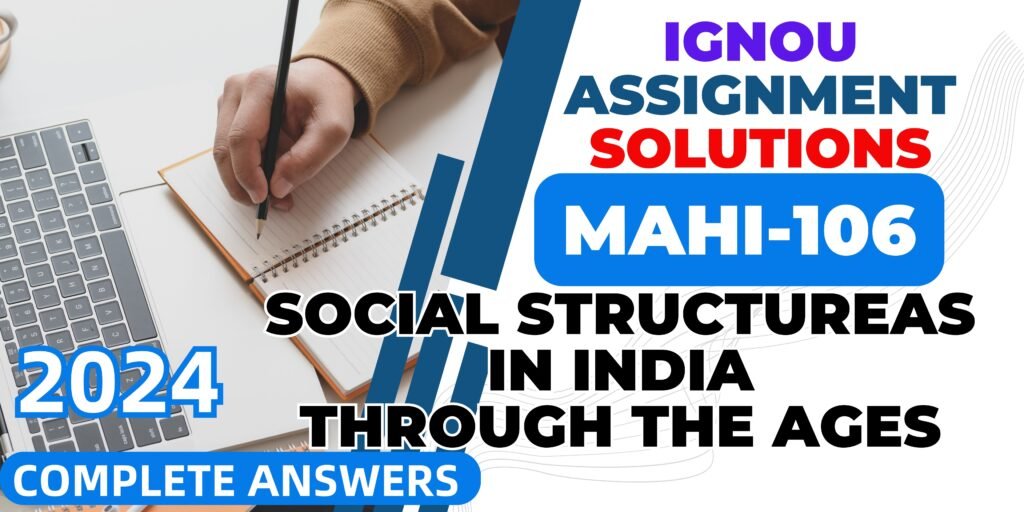IGNOU History Assignment 2024 Solutions (MAHI-106)
MHI-106: SOCIAL STRUCTUREAS IN INDIA
THROUGH THE AGES
Course Code: MHI-106
Assignment Code: MHI-106/AST/
TMA/January 2024
Total Marks: 100
Note: Attempt any five questions. The assignment is divided into two Sections ‘A’ and ‘B’. You have to attempt at least two questions from each section in about 500 words each. All questions carry equal marks.
SECTION A
- Discuss the role of objectivity and interpretation in writing the history of ancient India.
- Comment on the nature of the society in the Neolithic period
- What do rituals reveal about the nature of society in the Vedic period? Elaborate.
- Comment on the socio-religious and intellectual ferment that marked the rise of Buddhism and Jainism.
- Discuss what is meant by the early medieval society.
SECTION B
- Comment on the nature of rural society in the peninsular India.
- Discuss the origin and rise of the Rajputs with reference to the researches of B.D. Chattopadhyaya and N. Zeigler.
- How do you study tribes under colonialism? Discuss.
- Did colonialism shape the perceptions of caste? Discuss.
- Comment on the nature of social structures of the North East India under the colonial rule.
Click Here for Download Assignment Question Pdf
Answers
SECTION A
1. Discuss the role of objectivity and interpretation in writing the history of ancient India.
The study of ancient Indian history is a complex endeavor that requires a delicate balance between objectivity and interpretation. Objectivity involves presenting historical events and facts without bias, while interpretation involves analyzing and making sense of those facts. In the context of ancient Indian history, the interplay between objectivity and interpretation is crucial for constructing a comprehensive and accurate narrative. This essay will explore the roles of objectivity and interpretation in writing the history of ancient India.
Objectivity in Ancient Indian History:
Objectivity in historical writing is the foundation for constructing a reliable narrative. In the case of ancient Indian history, scholars strive to present events, artifacts, and primary sources without distortion or personal bias. Objectivity ensures that historical narratives are based on evidence rather than personal opinions, allowing readers to form their own conclusions.
In the pursuit of objectivity, historians of ancient India must navigate a landscape filled with diverse and sometimes conflicting sources. Sanskrit texts, archaeological findings, and inscriptions on monuments are valuable sources, but each comes with its own set of challenges. Objectivity requires careful scrutiny of these sources, considering their context, authorship, and potential biases.
For instance, when examining ancient Sanskrit texts, historians must be aware of the religious or political motivations of the authors. The Rigveda, for example, reflects the religious beliefs of the Vedic people, and interpreting it without considering the cultural context may lead to a skewed understanding. Objectivity demands a critical examination of these texts, acknowledging their limitations and potential biases.
Interpretation in Ancient Indian History:
While objectivity provides a factual foundation, interpretation allows historians to weave those facts into a coherent narrative. Interpretation involves making sense of historical events, identifying patterns, and understanding the motivations behind actions. In the context of ancient Indian history, interpretation plays a vital role in bridging gaps in the historical record and offering insights into the complexities of the past.
One of the challenges of interpreting ancient Indian history lies in the richness of its cultural and religious diversity. Different regions, dynasties, and periods witnessed unique social, political, and economic dynamics. Interpretation enables historians to synthesize these diverse elements, creating a narrative that captures the complexity of ancient Indian society.
For example, the interpretation of the decline of the Indus Valley Civilization requires connecting archaeological findings with climatic changes, migration patterns, and socio-economic factors. Without interpretation, the history of ancient India would remain a collection of disconnected events, lacking a cohesive understanding of the forces that shaped the subcontinent.
Balancing Objectivity and Interpretation:
Achieving a harmonious balance between objectivity and interpretation is crucial in writing the history of ancient India. Objectivity provides the necessary foundation, ensuring that historical narratives are rooted in evidence and facts. On the other hand, interpretation breathes life into those facts, offering a nuanced understanding of the complexities and motivations that drove historical events.
To strike this balance, historians must approach their work with humility, acknowledging the limitations of available sources and the inherent subjectivity of interpretation. Collaborative efforts among scholars from diverse backgrounds can also contribute to a more comprehensive and inclusive historical narrative.
In conclusion, the writing of ancient Indian history requires a delicate dance between objectivity and interpretation. Objectivity lays the groundwork for reliable historical narratives, emphasizing the importance of presenting facts without distortion. Interpretation, on the other hand, allows historians to make sense of those facts, offering a deeper understanding of the complexities of ancient Indian society.
The challenge lies in navigating the diverse and sometimes conflicting sources while maintaining a commitment to unbiased representation. As scholars continue to unravel the mysteries of ancient India, a thoughtful and balanced approach to objectivity and interpretation will contribute to a richer and more accurate historical narrative.
2. Comment on the nature of the society in the Neolithic period.
The Neolithic period, often referred to as the “New Stone Age,” marked a pivotal moment in human history, characterized by the transition from a nomadic, hunter-gatherer lifestyle to settled agricultural communities. This transformative era witnessed significant changes in technology, economy, social organization, and culture. In this essay, we will delve into the nature of Neolithic society, exploring key aspects that define this period and contribute to our understanding of early human civilization.
Agricultural Revolution and Sedentary Lifestyle:One of the defining features of Neolithic society was the Agricultural Revolution. During this period, humans learned to cultivate plants and domesticate animals, leading to the establishment of settled agricultural communities. The shift from a nomadic lifestyle to a sedentary one had profound implications for social organization. With the ability to produce food surplus, communities could sustain larger populations, resulting in the growth of villages and, eventually, towns.
Social Structure and Organization:The advent of agriculture laid the foundation for more complex social structures in Neolithic societies. As communities grew in size, a division of labor emerged. Individuals specialized in various tasks, such as farming, animal husbandry, pottery, and tool-making. This specialization fostered interdependence, creating a social fabric where cooperation and collaboration were essential for survival. The emergence of distinct roles contributed to the development of social hierarchies, with leaders or elders playing crucial roles in decision-making and conflict resolution.
Technological Advancements:The Neolithic period witnessed significant technological advancements, especially in the realm of tool production. The use of polished stone tools, such as axes and sickles, marked a departure from the crude implements of the Paleolithic era. These innovations not only facilitated agricultural practices but also improved efficiency in various daily tasks. Additionally, the development of pottery allowed for the storage and transportation of goods, contributing to the overall economic and social stability of Neolithic communities. (Continue…..)
Click Here for Complete Answer
Download Complete Answer PDF
-
MA History IGNOU MHI-101 Assignment Solution (Hindi Medium)
Original price was: ₹399.00.₹29.00Current price is: ₹29.00. Add to cart -
MA History IGNOU MHI-101 Assignment Solutions
Original price was: ₹399.00.₹29.00Current price is: ₹29.00. Add to cart -
MA History IGNOU MHI-102 Assignment Solution
Original price was: ₹399.00.₹29.00Current price is: ₹29.00. Add to cart -
MA History IGNOU MHI-104 Assignment Solution
Original price was: ₹399.00.₹29.00Current price is: ₹29.00. Add to cart -
MA History IGNOU MHI-105 Assignment Solution
Original price was: ₹399.00.₹29.00Current price is: ₹29.00. Add to cart -
MA History IGNOU MHI-106 Assignment Solution
Original price was: ₹399.00.₹29.00Current price is: ₹29.00. Add to cart -
MA History IGNOU MHI-107 Assignment Solution
Original price was: ₹399.00.₹29.00Current price is: ₹29.00. Add to cart
IGNOU History Assignment 2024 Solutions IGNOU History Assignment 2024 Solutions IGNOU History Assignment 2024 Solutions IGNOU History Assignment 2024 Solutions IGNOU History Assignment 2024 Solutions IGNOU History Assignment 2024 Solutions IGNOU History Assignment 2024 Solutions IGNOU History Assignment 2024 Solutions IGNOU History Assignment 2024 Solutions IGNOU History Assignment 2024 Solutions IGNOU History Assignment 2024 Solutions IGNOU History Assignment 2024 Solutions IGNOU History Assignment 2024 Solutions










